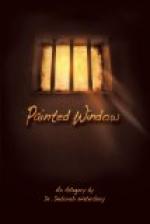Few men are more effective in soliloquy. It is a memorable sight to see him standing with his back to one of the high stone mantelpieces in Durham Castle, his feet wide apart on the hearth-rug, his hands in the openings of his apron, his trim and dapper body swaying ceaselessly from the waist, his head, with its smooth boyish hair, bending constantly forward, jerking every now and then to emphasise a point in his argument, the light in his bright, watchful, sometimes mischievous eyes dancing to the joy of his own voice, the thin lips working with pleasure as they give to all his words the fullest possible value of vowels and sibilants, the small greyish face, with its two slightly protruding teeth on the lower lip, almost quivering, almost glowing, with the rhythm of his sentences and the orderly sequence of his logic. All this composes a picture which one does not easily forget. It is like the harangue of a snake, which is more subtle than any beast of the field. One is conscious of a spell.
The dark tapestried room, the carved ceiling, the heavy furniture, the embrasured windows, the whole sombre magnificence of the historic setting, quiet, almost somnolent, with the enduring memories of Cuthbert Tunstall and Butler, Lightfoot and Westcott, add a most telling vivacity to the slim and dominating figure of this boylike bishop, who is so athletic in the use of his intellect and so happy in every thesis he sets himself to establish.
It is an equally memorable sight to see him in his castle at Bishop Auckland in the role of host, entertaining people of intelligence with the history of the place, showing the pictures and the chapel, exhibiting curious relics of the past—a restless and energetic figure, holding its own in effectiveness against men of greater stature and more commanding presence by an inward force which has something of the tang of a twitching bow-string.
So much energy would suggest a source of almost inexhaustible power. But that is perhaps the greatest disappointment of all in the Bishop’s psychology. In the case of Dr. Inge one is very conscious of a rich and deep background, a background of mysticism, from which the intellect emerges with slow emphasis to play its part on the world’s stage. In the case of Bishop Ryle one is conscious behind the pleasant, courtierlike, and scholarly manner of a background of very wholesome and unquestioning moral earnestness. But in Dr. Henson one is conscious of nothing behind the intellect but intellect itself, an intellect which has absorbed his spiritual life into itself and will permit no other tenant of his mind to divert attention for a single moment from its luminous brilliance, its perfection of mechanism.
One may be quite wrong, of course; one can speak only of the impression which he makes upon oneself and perhaps a few of one’s friends; but it would almost seem as if he had ever regarded Christianity as a thesis to be argued, not a religion to be preached, a principle to be enunciated, not a practice to be extended, a tradition to be maintained, not a passion to be communicated.




